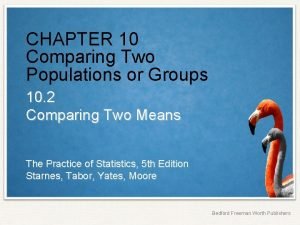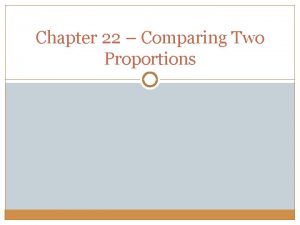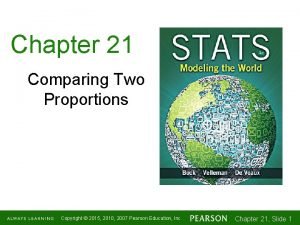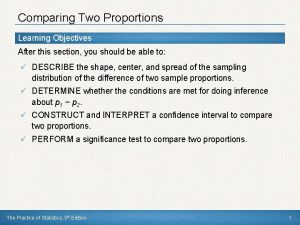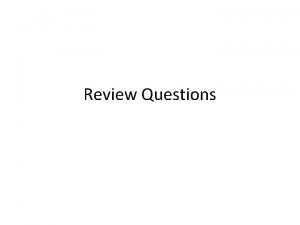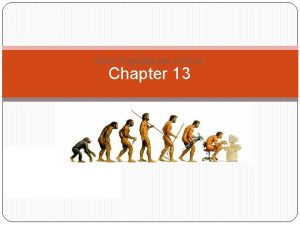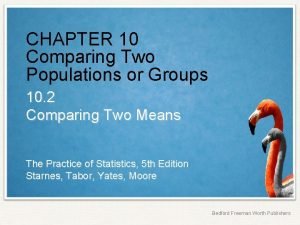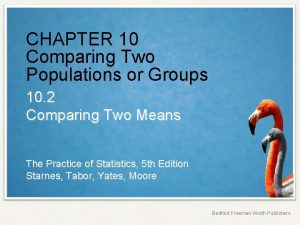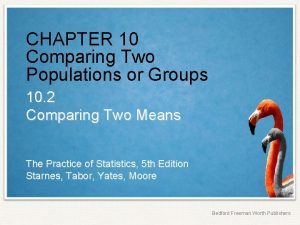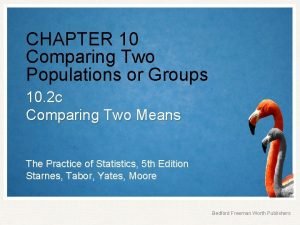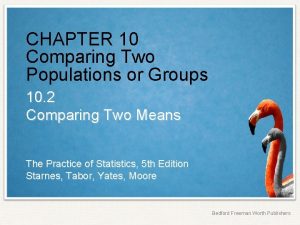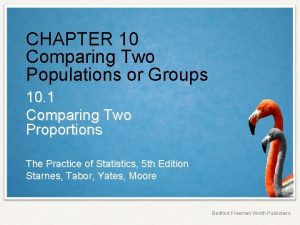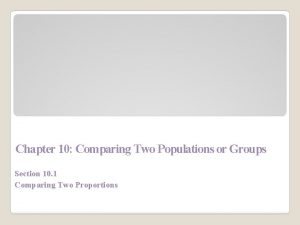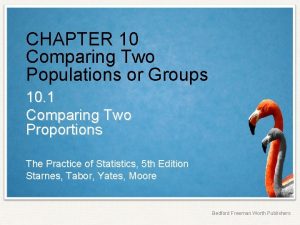CHAPTER 10 Comparing Two Populations or Groups 10











- Slides: 11

CHAPTER 10 Comparing Two Populations or Groups 10. 2 Comparing Two Means The Practice of Statistics, 5 th Edition Starnes, Tabor, Yates, Moore Bedford Freeman Worth Publishers

Warm Up • Check your understanding p. 628 The Practice of Statistics, 5 th Edition 2

Comparing Two Means Learning Objectives After this section, you should be able to: ü DESCRIBE the shape, center, and spread of the sampling distribution of the difference of two sample means. ü DETERMINE whether the conditions are met for doing inference about µ 1 − µ 2. ü CONSTRUCT and INTERPRET a confidence interval to compare two means. ü PERFORM a significance test to compare two means. ü DETERMINE when it is appropriate to use two-sample t procedures versus paired t procedures. The Practice of Statistics, 5 th Edition 3

Introduction What if we want to compare the mean of some quantitative variable for the individuals in Population 1 and Population 2? Our parameters of interest are the population means µ 1 and µ 2. The best approach is to take separate random samples from each population and to compare the sample means. Suppose we want to compare the average effectiveness of two treatments in a completely randomized experiment. We use the mean response in the two groups to make the comparison. The Practice of Statistics, 5 th Edition 4

The Sampling Distribution of a Difference Between Two Means To explore the sampling distribution of the difference between two means, let’s start with two Normally distributed populations having known means and standard deviations. Based on information from the U. S. National Health and Nutrition Examination Survey (NHANES), the heights (in inches) of ten-year-old girls follow a Normal distribution N(56. 4, 2. 7). The heights (in inches) of ten-year-old boys follow a Normal distribution N(55. 7, 3. 8). Suppose we take independent SRSs of 12 girls and 8 boys of this age and measure their heights. The Practice of Statistics, 5 th Edition 5

The Sampling Distribution of a Difference Between Two Means Using Fathom software, we generated an SRS of 12 girls and a separate SRS of 8 boys and calculated the sample mean heights. The difference in sample means was then be calculated and plotted. We repeated this process 1000 times. The results are below: The Practice of Statistics, 5 th Edition 6

The Sampling Distribution of a Difference Between Two Means The Sampling Distribution of the Difference Between Sample Means Choose an SRS of size n 1 from Population 1 with mean µ 1 and standard deviation σ1 and an independent SRS of size n 2 from Population 2 with mean µ 2 and standard deviation σ2. The Practice of Statistics, 5 th Edition 7

The Sampling Distribution of a Difference Between Two Means The Practice of Statistics, 5 th Edition 8

The Two-Sample t Statistic If the Normal condition is met, we standardize the observed difference to obtain a t statistic that tells us how far the observed difference is from its mean in standard deviation units. The Practice of Statistics, 5 th Edition 9

The Two-Sample t Statistic The two-sample t statistic has approximately a t distribution. We can use technology to determine degrees of freedom OR we can use a conservative approach, using the smaller of n 1 – 1 and n 2 – 1 for the degrees of freedom. The Practice of Statistics, 5 th Edition 10

The Two-Sample t Statistic Conditions for Performing Inference About µ 1 - µ 2 • Random: The data come from two independent random samples or from two groups in a randomized experiment. o 10%: When sampling without replacement, check that n 1 ≤ (1/10)N 1 and n 2 ≤ (1/10)N 2. • Normal/Large Sample: Both population distributions (or the true distributions of responses to the two treatments) are Normal or both sample sizes are large (n 1 ≥ 30 and n 2 ≥ 30). If either population (treatment) distribution has unknown shape and the corresponding sample size is less than 30, use a graph of the sample data to assess the Normality of the population (treatment) distribution. Do not use two-sample t procedures if the graph shows strong skewness or outliers. The Practice of Statistics, 5 th Edition 11
 Chapter 10 comparing two populations or groups crossword
Chapter 10 comparing two populations or groups crossword Chapter 10 comparing two populations or groups
Chapter 10 comparing two populations or groups Chapter 22 comparing two proportions
Chapter 22 comparing two proportions Standard error of difference between two proportions
Standard error of difference between two proportions Chapter 22 comparing two proportions
Chapter 22 comparing two proportions Chapter 22 comparing two proportions
Chapter 22 comparing two proportions Chapter 22 comparing two proportions
Chapter 22 comparing two proportions A biologist discovers two populations of wolf spiders
A biologist discovers two populations of wolf spiders How are ethnic groups and religious groups related
How are ethnic groups and religious groups related Chapter 16 evolution of populations vocabulary review
Chapter 16 evolution of populations vocabulary review Chapter 13 how populations evolve test
Chapter 13 how populations evolve test Chapter 17 evolution of populations answer key
Chapter 17 evolution of populations answer key

